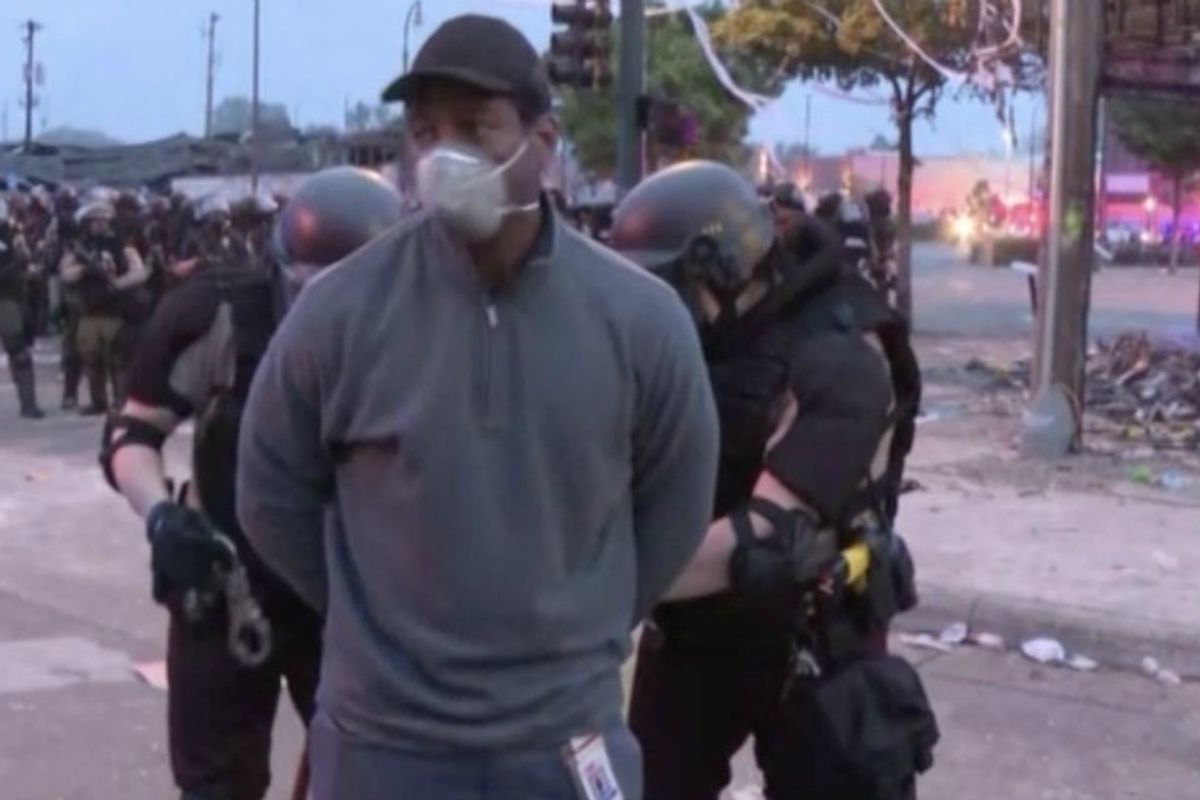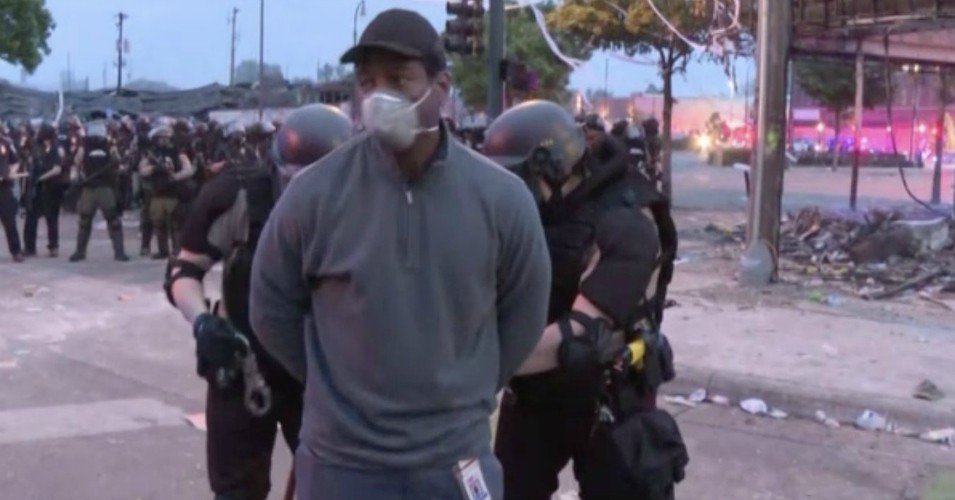Retired police officer says 'brother in blue' code likely to blame for George Floyd's death.

Omar Delgado, a first responder at the Pulse nightclub mass shooting in 2016, still grapples with the nightmare. As shots were fired then, Delgado quickly moved bloodied victims outside. As he took cover, the firing continued. There were lifeless bodies everywhere. One of the survivors he helped was Angel Colon, who was shot six times. The two made headlines everywhere. I even interviewed them back then.
But despite Delgado's heroic actions, he was fired from the Eatonville, Florida police force the following year after developing post-traumatic stress disorder from the massacre—six months before his vested pension. He filed a lawsuit against the department, and he was eventually granted disability retirement, which was 42% of his $38,500 salary. Nowadays, former officer Delgado can't believe what our world has come to. In some ways, he says, things have become progressively worse.
Protesters are breaking windows, igniting fires and vandalizing properties in Minneapolis over the killing of George Floyd, who is a black man. A video surfaced of him struggling to breathe while the knee of a white police officer was pressed against his neck. You can hear Floyd repeating "I can't breathe," also voicing that he's about to die. Finally, when the officer released pressure, you can see Floyd's limp body on the pavement. He was pronounced dead at the hospital. "It's horrific. He couldn't breathe. It's not like he was tugging or fighting. It was extremely unnecessary," says Delgado. "My heart goes out to the family and his friends. To see that situation, it's just really, really bad."
Delgado wants people to know that not all officers are like Derek Chauvin. He believes those four officers that day put a bad name to the badge. "As a former police officer, and I'm Puerto Rican, it's frustrating and it's sad. But I wish people would not think every officer is the same way," he says. "I know there are officers out there right now who are thinking, 'I have to get up, I have to put this uniform on. I have to serve and protect, but you know what? I'm going to get shit for it because of them.'"
Delgado mentions most things had to do with race when he was an officer. When they would call in, the first thing asked was the ethnicity of the driver. "I don't know why they were doing that. They always wanted to know. But why? I never understood," he says. "It really didn't matter what race they were."
During training, Delgado was always taught to subdue and contain the suspect. Once the person was in cuffs, the officer gauges if the individual is a threat. Sometimes they'll kick or spit, but Delgado doesn't believe there is ever a time an officer should use brutal force if a suspect is contained. "In my opinion, what should that officer have done? Once [Floyd] was on the ground and already contained, the officer should have picked him up and put him in the car. He shouldn't have been on him like that. It's absurd."
But Delgado feels training only goes so far. "We are in 2020 and I don't think it will ever get better. It hasn't happened yet. There will always be that persona of police brutality or injustice or something you think an officer should have done it differently. I still would love to know what [Chauvin] was thinking that moment. It doesn't make sense. And sadly, the man lost his life."
As for the other officers, Delgado thinks the "brother in blue code" may have applied here. "Those three other officers did not come to their senses and say, 'Enough is enough.' "There is this thing where they have the officer's back no matter what. But look what happened. They lost their jobs. They could have said, 'Stop, enough,' he says. "They didn't. It's terrible."
He admits that the brother in blue code of always having the back of another officer is a real thing, but common sense is more important. "Some officers don't have it. It doesn't look good. Those are the ones who shouldn't be officers," he says. "There was no need to be the tough guy, the macho man. The officer probably thought if he backed down, he would show weakness. Having weakness out on the streets as an officer is bad. But they should have shown brotherly love and professionalism. How many poor black people are treated like that on a daily basis? How many poor white people are treated like that? It happens a lot. This should be an eye opener."
After the 2012 Trayvon Martin case, where an unarmed, black 17- year-old was shot and killed in Sanford, Florida, Delgado believes that's when police officers got a really bad reputation. The ensuing trial in 2013 acquitted George Zimmerman of second degree murder, which sparked national debate around gun violence and racism. "All these officers were then beating up black people. I couldn't believe it," says Delgado. But then the Pulse shooting occurred, he says, and people looked at the officers as heroes, and put them in a better light. Now, he believes, things have come full circle. "But that doesn't mean people should be looting, trashing and destroying other people's property," he says. "Why are they doing it? They're upset. They should be. I get it. But why damage other people's property that has nothing to do with it? I don't think that's the right way to voice an opinion."
Delgado isn't shy to voice his own opinions either. "It shouldn't be about race, but it's hard to paint that picture when you see what you see. But right away, everyone wants to put a title on racism," says Delgado. "Yes, it is a white officer and a black victim, but that's what makes it look like race. But if it's the opposite, do they ever smash out the race card? Are they in a hurry to pull out the race card if it was a black officer and a white victim. Would they? If it was hispanic, or asian, or another race? To me, it's a crime on an individual and a person."
Delgado was also labeled as a racist while he was an officer in his predominantly black town in Eatonville. "I've never been somebody who plays the race card. My grandfather was blacker than black. My mom is whiter than white. I never saw color. If you look at the history of Puerto Ricans, we are mixed with a whole bunch of people and race. People used to say, 'You're racist.' And I'd say, 'Really? I'm Puerto Rican.' Then I was fine," he says.
But people were quick to put labels on him, telling him that he was racial profiling. "I would say, 'Are you serious?' The whole town is almost black!'" he quips." Second of all, if I pulled that vehicle over, I sometimes can't tell who is even driving, since the windows are tinted. I pull over a vehicle at a high rate of speed. People are quick to lash out. But it doesn't mean I'm going to treat anyone differently. I'm going to treat everyone with the respect they deserve."
The best word to describe how Delgado is feeling lately is numb."I know how bad the world is through my own experience, witnessing all of it first hand. What gets me is that people are not learning from what's going on. You would think after all these incidents that have been happening, there would be more training to officers."
But the real question is how do things change?
"There are a lot of black chiefs of police out there. Do you start off at the top and give them more jobs? I don't know if officer [Chauvin] acted that way because [Floyd] was black. What I do know is the way that officer acted was totally unacceptable. He was wrong at every level," he says.
Delgado believes officers aren't protecting only whites or only blacks. They are protecting the community. When things like this happen, he realizes that the public has a difficult time trusting police again. "That is the most challenging part. You respect the profession because you know what they are there for, but when the profession fails you, that is a tough pill to swallow. I don't have all the answers, but I do know things need to change."







 Rihanna Nails GIF
Rihanna Nails GIF

 Good luck trying to catch a gazelle.
Good luck trying to catch a gazelle. Chickens will eat just about anything.
Chickens will eat just about anything. There's actually a big difference between horses and zebras besides just the stripes.
There's actually a big difference between horses and zebras besides just the stripes. Stop Right There The End GIF by Freeform
Stop Right There The End GIF by Freeform